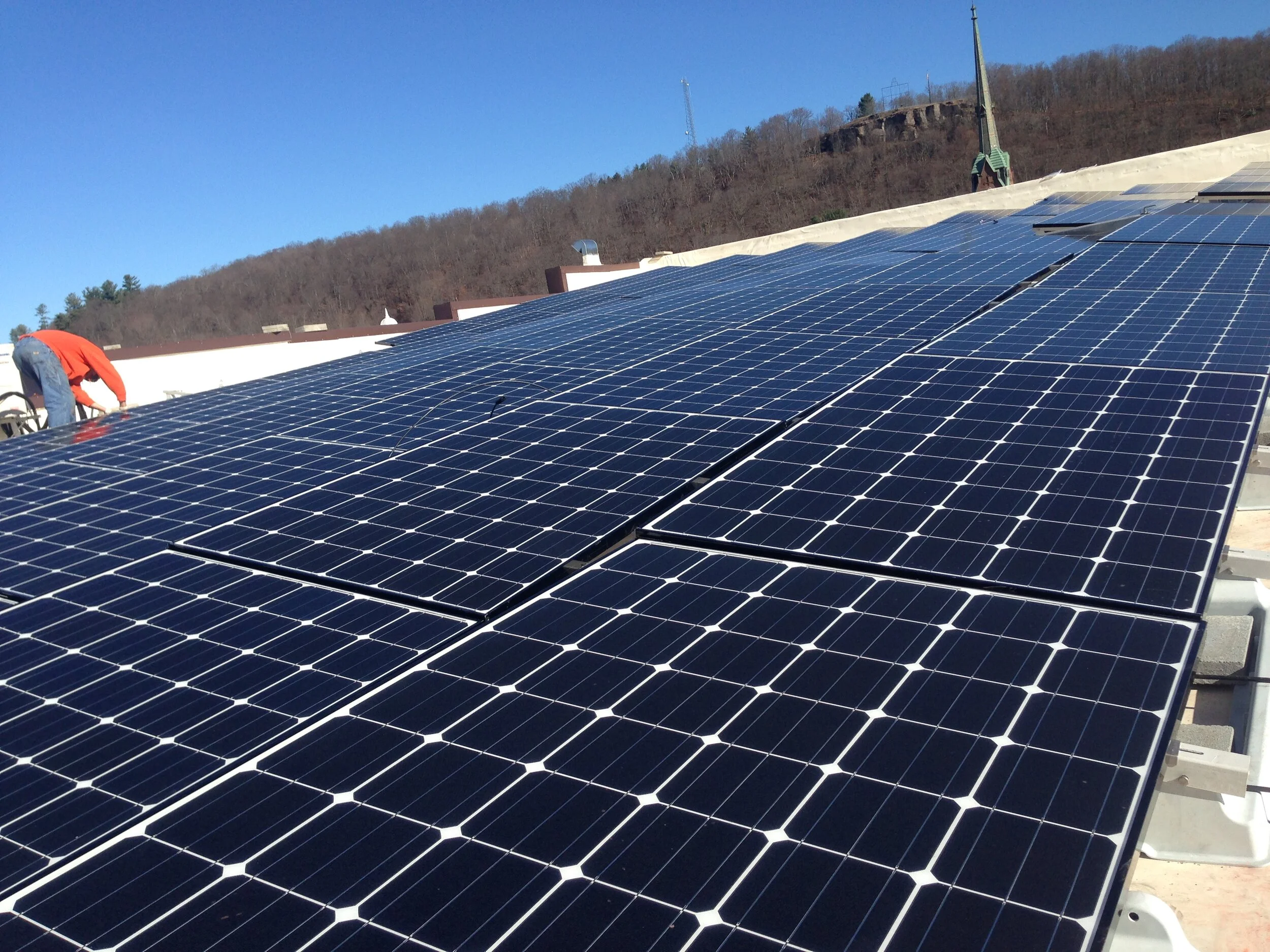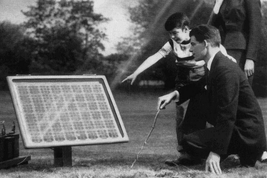The Clean Energy Toolkit
Click HERE for the Clean Energy Toolkit.
FAQs about Solar and our Co-op
Can any site have a solar PV system?
For a PV system to be practical and make financial sense, it must be oriented to get lots of sunshine. For our area, that means facing south (within 45 degrees), tilted up 10-45 degrees (so the snow will fall off) and without trees, power lines, chimneys etc. shading it, even in winter when the sun doesn't get very high in the sky. If your roof is a poor location, sometimes a ground-mount system can be used instead.
What are the potential safety concerns of having a PV system on my property?
When professionally installed a PV system is fully UL certified and compliant with all building and electrical codes. Just like any electrical device, the system should not be played on, or have wiring exposed. As a host, you just keep it secure, as you would any other electrical system on your property. If you notice any damage or have a concern about a Co-op owned system, then please report it to the Co-op.
How are PV panels attached and what is the extra weight on my roof?
The attachment methods depends on the roofing material. Except for flat roofs, or standing seam metal roofs, PV arrays are usually attached with lag bolts into the underlying building structure. Since PV modules will last 25 or more years it will always be better if installed on a newer roof, generally those <10-12 years old. PV arrays generally weigh less than 4 lbs per square-foot.
How well do PV panels hold up in the cold, snow or hail?
PV panels can survive 1-inch hail without problems. See this video for one manufacturer's testing (with baseballs too). Cold weather, no problem! Solar panels actually get more efficient in cold temperatures, and when sunlight is reflected off surrounding snow. Yes, fresh snow may stick to panels initially, but with a good tilt angle and the smallest of sunshine hitting the array, it will soon slide right off.
How much does it cost to install a PV system?
Professionally installed Residential and small Commerical PV systems, using mostly domestic components (if available), generally cost between $2.50 and $3 per watt of capacity. Ground-mount systems or those with complex construction will cost more. Imported components or larger scale systems may be less expensive.
With a PV system, can I go 'off-the-grid' and ditch my electric utility?
The most common type of PV system, and those installed by the Co-op, do not have batteries and must be connected to the grid in order to operate. Therefore a host must still pay the monthly utility connection charges as well as for any electricity used greater than the PV system's annual production (under a net-metering tariff).
How long does it take for the energy produced by a PV panel to 'make up' for the energy that was used in manufacturing it?
This 2008 article in Home Power magazine is an excellent analysis of this question based on a detailed European study. The answer then for a poly-crystalline panel installed at an 'average site' was 1.7 years. Note: for a new PV system installed today in NEPA without any shading, we would expect ~10% better efficiency. Also note that coal and other fossil fuel-based electricity NEVER 'makes up' for the energy used to extract, transport, and process the fuel.
What hazardous materials are used in manufacturing PV panels and how does that compare to other energy sources?
This article from the Solar Energy Industry Association details the various materials and waste byproducts used in solar cell manufacturing. In 2013 a widely-publicized San Jose State University study looked at hazardous waste handling by the PV industry in California from 2007 to 2011, and found several concerns. Anti-solar groups appear to be using that to put fear, uncertainty and doubt into the public mind about solar. What's key to remember is that the "energy derived from natural gas and coal-fired power plants creates more than 10 times more hazardous waste than the same energy created by a solar panel," according to the study's author.
If you have other questions, especially if you are a potential host for a Co-op financed PV system, please contact us.
A brief overview of Solar Energy
April 25, 1954: Bell Labs demos practical solar cell
Solar energy comes in several forms: thermal/heat, chemical (e.g. the result of what plants do with sunlight to make food), and electrical. In nature, electrical storms are an indirect result of heating of the earth's atmosphere by the sun. In 1839, a 19 year-old French physicist, Edmond Becquerel, working in his father's laboratory, invented the first "solar cell" and discovered the photovoltaic effect, when sunlight shining on his invention produced an electrical current. Becquerel went on to discover other electrical effects and photographic processes, but his solar cell never 'saw much light' as it was impractical outside of a chemistry lab. It took Albert Einstein in 1905 to fully explain how and why it works, for which he was awarded the 1921 Nobel Prize. It wasn't until 1954 that Bell Laboratories publicly revealed the first practical solar cell, built using a silicon semiconductor and without fluids or any moving parts. So began the modern solar PV industry.
Modern solar PV panels (also called modules) are generally made up of a series of silicon solar cells, soldered and laminated under tempered glass, then bound within an aluminum frame. PV technology has greatly benefited from the manufacturing advances driven by the electronics industry's need for greater purity for its silicon ingots. The electrical generation capacity (measured in watts) of a solar cell varies with its exposed area, light intensity, temperature, and the quality of the semiconductor material. Silicon solar cells are typically either mono-crystalline (a solid/single color, with energy conversion efficiency of up to 20-25%) or poly-crystalline (multiple shades from random shapes within the cell; less efficient per unit area, but also less costly). Solar cells can also be made from flexible thin-films or even 'printed' with an ink-jet, but these are even less efficient. Some super efficient (approaching 45%) solar cells, such as for spacecraft and the International Space Station, are instead made from gallium arsenic (GaAs), but are extremely expensive and not at all common. This video from the US DoE provides some basic info on how PV panels work.
Today's typical PV modules weigh about 45-50lbs each, are approx. 1.25 inches thick, by 60-66 inches by 35-40 inches, and vary in capacity from 200W to 350W (or more), as tested under "standard test conditions" (STC) by an external testing lab. UL listed manufacturers are required to include the module's rated capacity and other important electrical specifications on the label attached to every panel. Because the modules have no moving parts to break, manufacturers usually warranty the production capacity of their modules for 25 years, with only 0.5% decrease/year. Some modules installed in the 1970s are still operating today and often have better production than that.
PV modules produce direct current (DC) electricity, but most of the electricity we use, and that a utility supplies to our homes and businesses is alternating current (AC). Therefore most PV systems include one or more "inverters" to convert from DC to AC electricity; but in that process (and in the wiring & other components too), some power is lost (converted to waste heat). This, and the fact that sunshine intensity depends upon the location and orientation of the modules, and with weather and by season, means the "nameplate" (labelled) capacity of the modules can not just be added together to determine a PV system's power output (measured in kilowatts) or determine its electricity production (measured in kilowatt-hours, or kWhr). Fortunately, the National Renewable Energy Labs has a comprehensive web-based modelling tool, named PVWatts, that forecasts PV system production, using local historical weather data and other system design information we provide.



